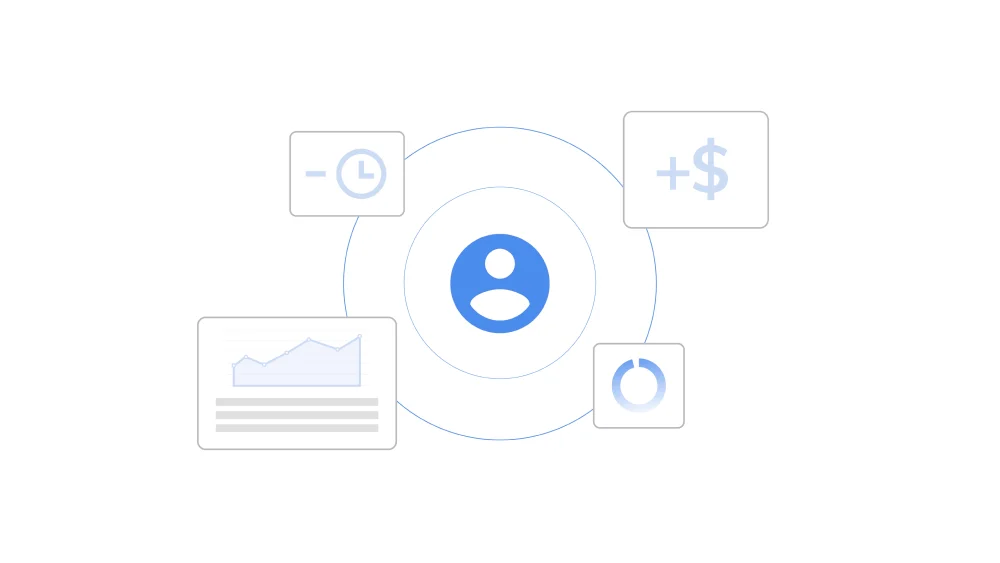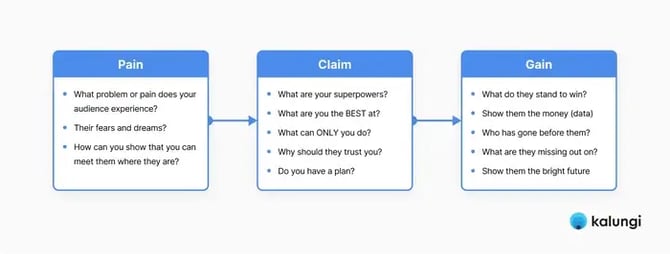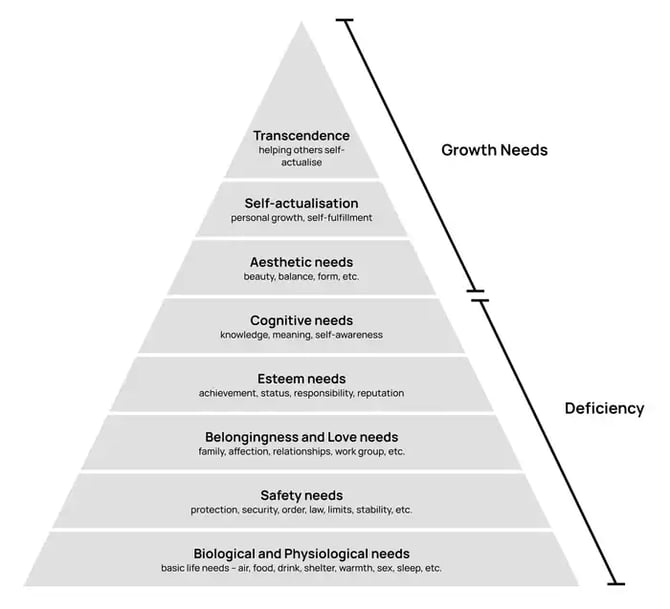How to write technical content for SaaS products
Learn more about our pro tips for how to write good, valuable technical content for software products–regardless of your technical expertise.

The biggest messaging mistake B2B SaaS companies make is writing with self-centric messaging.
Instead of talking about yourself as a company, you should be talking to your prospects and target customers.
An important part of a marketer’s role is storytelling: setting the stage, illustrating the conflict, and introducing a hero to save the day.
At Kalungi, we use the ‘Pain-Claim-Gain’ framework to tell these brand stories. Our prospects are the hero, their current situation is the conflict, and the SaaS product is the outcome.

SaaS buyers often experience pains and challenges that lead them to explore a new software product--from lack of feature functionality and the right workflows to poor navigation that leads to lack of digital adoption.
As a B2B marketer communicating highly technical product specs and features to a non-technical audience, connecting your persona’s pain points with your ‘claims’ and what they eventually gain is important.
Communicating the pains and the claims is straightforward. Sharing the gains, however, gets a little more complicated.
You can’t just tell your prospects your SaaS product is essential. You have to say why and how your product is essential to them because without the “so what,” you can’t connect the dots between your claims and pains.
In the video below, Mike explains the How/Why ladder—a tool we use to create product messaging to communicate pains, claims, and gains across all the relevant personas.
Simply put, the ‘gains’ are the key outcomes and benefits of your SaaS product(s) and services. What do your customers get from your SaaS products?
Product and copywriting professionals know how to make promises, and reinforcing these claims with actual results helps you provide reassurance and confidence (making the buyer’s journey easier and smoother).
Our pains-claims-gains storytelling aligns with Maslow’s hierarchy of needs:

With this in mind, we categorize gains into three categories: financial, strategic, and personal. With each of these, you should be moving closer to the top of the pyramid. Financial gains align with safety, strategic improvements align with esteem, and personal gains align with self-actualization.
Examples of these in your marketing communications might include:
We use ten main ways to prove and validate SaaS product claims that you can implement throughout marketing messaging, from one-pagers to blogs. Let’s explore why each one works and how these gains might sound.
Marketing can get a bad rap, especially when it comes to misleading customers.
That’s why one of the most powerful tools in SaaS marketing is testimonials from happy customers. To figure out what real-life gains your SaaS users experience, set up a 30-minute call and let them do the talking.
Your three SaaS personas will care about different things:
|
Personal (P1) |
|
|
Financial (P2) |
|
|
Strategic (P3) |
|
If your company doesn’t have any social proof to pull from, start now. You can use Kalungi’s testimonial question template to guide your interviews and record the meeting for a voice of the customer testimonial.
Talk is cheap, and more and more prospects are distrustful of marketing communications. Show your prospects (and current customers) how and why your product will make their work and lives better through product demos, free trials, or freemium versions.
Product demos will likely showcase the benefits of your SaaS product across personal, financial, and strategic like:
|
Personal (P1) |
|
|
Financial (P2) |
|
|
Strategic (P3) |
|
When demos and social proof fail, turn to hard numbers (which are more credible than words). Don’t make empty promises, and back up your claims with hard statistics that have been proven over time.
|
Personal (P1) |
|
|
Financial (P2) |
|
|
Strategic (P3) |
|
If you don’t have specific ROI statistics, consider what other numbers you can use to your advantage. Instilling trust through proof such as total number of customers, countries served, people managed, or years in service can establish your expertise and credibility just as well.
The final category of communicating gains is through consistent and clear thought leadership. Assert yourself and take a stand on your industry, market, and best practices. Have an opinion now and on what’s next, and you’ll become an influential voice that your prospects and current customers get value from.
Through thought leadership, you can position your company and SaaS product(s) in a unique way that demonstrates both your credibility and as a problem-solver for your marketplace.
|
Personal (P1) |
|
|
Financial (P2) |
|
|
Strategic (P3) |
|
If you’ve never experimented with thought leadership before, that’s ok -- make a list of questions you or your customer-facing roles are frequently asked, challenges you (or your customers) run into, and
You can turn these ideas into valuable content like webinars, blogs, social media posts, infographics, short video clips, and whitepapers. This adds value to your users and prospects that build trust and get them closer to their personal, financial, or strategic goals.
If you don’t have any messaging guide in place, you can get started with Kalungi’s free messaging guide template. Plus, check out the following blogs to get started with positioning your SaaS company in your market:
A content marketing specialist at Kalungi, Liz enjoys writing and learning about anything and everything. Since obtaining her BA in English and her BS in Marketing at NC State, she's carved a path educating, engaging and exciting B2B SaaS markets through powerful content and messaging.
Learn more about our pro tips for how to write good, valuable technical content for software products–regardless of your technical expertise.
Here are multiple articles/a video about the different aspects of creating, optimizing and evolving your pricing strategy for SaaS products and...
Why are SaaS product review sites important? SaaS product review sites are the first place many B2B buyers go to conduct their research.
Be the first to know about new B2B SaaS Marketing insights to build or refine your marketing function with the tools and knowledge of today’s industry.